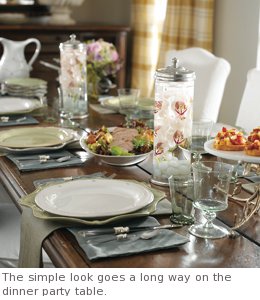 Thanksgiving, Hanukkah, Christmas, New Year’s Eve—not to mention the family lunches, brunches and dinners that happen this time of year.
Thanksgiving, Hanukkah, Christmas, New Year’s Eve—not to mention the family lunches, brunches and dinners that happen this time of year.
If you’re a cook, it’s high season. The time of year when you can dazzle and feed, without restraint.
But no matter how great your culinary (or purchasing) skills, it’s hard to make your food look as good as it tastes. Professionally plated food—with swirls of sauce and perfectly chopped garnishes—just looks better. And buffets arranged by caterers look more appetizing then the random bowls and platters of food laid out in a row by the home cook.
I would offer my last buffet as an example of a “don’t.” One blue bowl, a reddish transferware platter, a wooden salad bowl and a pewter platter, followed by dark green plates—all arranged one after another in a dull row. While the food tasted delish, the presentation was as random as a neighborhood block party.
Stephen Hamilton and Johanna Lowe make their living making food look good. Hamilton is a Chicago photographer whose work can be seen on Top Chef (those beautiful food portraits in the chef quarters) and Lowe is a stylist whose Chicago and Michigan studios do work for some of the biggest names in the advertising world. They have great tips to make your food look as good as it tastes, whether you’re contemplating a blow-out holiday bash or a more intimate dinner party. 1. Keep the presentation simple and clean.
1. Keep the presentation simple and clean.
“People tend to go overboard,” Hamilton says. “A lot of times it backfires. Go for simple, clean presentations and flavors.” Each plate or platter doesn’t need to be overloaded with food and garnish. Leave some space and don’t overwork the garnish. “Make sure the garnish is appropriate to the dish you’re serving, like turkey with sage,” Lowe says. She gently fries the sage leaves so they’re translucent and shiny before using them as garnish.
2. Limit your color palate.
Instead of my random rainbow of bowls and platters, I should have used one simple, solid color—if not white, then Hamilton recommends a light, icy blue that complements the warm browns of fall foods. Lowe limits patterned servers to, at most, one colorful platter in the middle of the table. On solid plates, food is the center of attention, but one pretty platter keeps everything from being too monochromatic.
3. Vary heights for a buffet.
Rich Hernandez, a managing partner at Simply Delicious Gourmet Catering in Palatine, uses risers to elevate some dishes. It’s a simple catering trick that home cooks almost never use. Glass blocks or pedestal cake platters let you start higher in the middle of the table and then step down toward the edges.
4. Visualize the food on a plate.
Lowe’s plates are beautiful compositions of color and height. Certainly not little blobs of separate food. She packs rice in a cup so it’s a perfectly shaped mound and has a little height. Sauces are squiggled onto the plate. You can easily replicate that trick with a plastic squeeze bottle and a little practice. But don’t go crazy. One squiggle looks inspired; three different sauce squiggles plus a parsley sprig and diced tomato bits will just look busy.
5. Think chic with white plates and an organic, natural look.
“Strive for a plate and table that looks effortless and naturally beautiful,” Lowe says. Avoid the plastic and shiny, and instead think natural and organic. Hamilton tells of a party where they emptied out his prop room and used everything. “Hideous!” he says. It’s tempting at the holidays to pull out Grandma’s china and your wedding gifts and the expensive platter your husband’s boss gave you, but resist. “As an artist, you have to know when to stop,” Hamilton says. “Less is more.”
